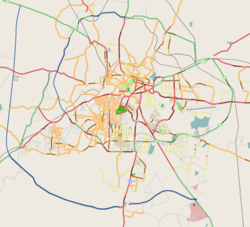Bugle Rock | |
|---|---|
neighbourhood | |
 A soldier with bugle at the Bugle rock | |
| Coordinates: 12°56′35″N 77°34′10″E / 12.94303°N 77.56947°E | |
| Country | |
| State | Karnataka |
| District | Bangalore Urban |
| Metro | Bengaluru |
| Languages | |
| • Official | Kannada |
| Time zone | UTC+5:30 (IST) |

Bugle Rock (Kahale Bande) is a massive rock in the Basavanagudi area of South Bangalore, in the state of Karnataka. It is an abrupt rise above the ground of peninsular gneiss as the main rock formation and with an assessed age of about 3,000 million years. Bugle Rock has generated wide interest among the scientific community.[1]
Kempe Gowda II (who came to power in 1585), the feudal ruler of Bangalore, is credited with building four watchtowers setting limits for Bangalore's expansion, which included a tower on the Bugle Rock (on the southern boundary) as it commands a panoramic view of Bangalore city. It is said that at sunset a sentry would blow the bugle and hold a torch (Kannada:panju) which was visible from the other three watch towers (one on the southern bank of the Kempambudi tank on the west, the second near Ulsoor Lake in the east and the third tower adjoining Ramana Maharshi Ashram on Bellary Road, namely Mekhri Circle in the north). This was done to inform people that everything was safe at that location and to give a warning bugle call to alert the citizens of any intruders into the city.[1][2][3] Most of the rocks on the Bugle Rock, next to the Bull Temple, have hollows, which were once used to light lamps.[4][5] This landmark spreads over an area of 16 acres (6.5 ha).[6] This rock is contiguous and similar to the rock at Lalbagh tower.[7]
- ^ a b Raman, A (1994). Bangalore - Mysore - A Disha Guide. Orient Blackswan. p. 8. ISBN 9780863114311.
- ^ "Bugle rock". Retrieved 5 January 2009.
- ^ "The History of Bangalore". Retrieved 9 January 2009.
- ^ "Bull Temple and Bugle Rock, A brief visit in pictures". Archived from the original on 30 July 2009. Retrieved 5 January 2009.
- ^ "Tunnel of time". Retrieved 5 January 2009.
- ^ "A walk in the park in Basavanagudi". Archived from the original on 14 August 2010. Retrieved 5 January 2009.
- ^ "Bangalore>City Tour". Retrieved 5 January 2009.
